During Parrikar's visit, Washington signalled that it has changed its mind. "Secretary (of Defense Ashton) Carter informed Minister Parrikar that in light of the strengthening relationship between the United States and India, the (US Department of Defense) has updated its policy on gas turbine engine technology transfer to India. As a result of this policy update, the Secretary is confident that the United States will be able to expand cooperation in production and design of jet engine components," says the joint statement issued on Friday by the Indian Embassy in Washington. That opens the doors for GE and DRDO to work together in uprating the F-414S6 engine, which India has already selected for the indigenous Tejas Mark II. This will enhance the current engine's peak power of 90 KiloNewtons (KN), delivering 110 KN of thrust. The AMCA's twin F-414 Enhanced Engine will thus deliver an awesome 220 KM of peak power. The green signal for co-developing this engine appears to have been given, with the joint statement saying: "Secretary Carter and Minister Parrikar look forward to US companies working with their Indian counterparts to submit transfer requests that will benefit from this updated policy."
For GE, this could be a commercial windfall, providing it an assured market for all India's indigenous fighters. This would include 100 F-404 engines for the Tejas Mark I, another 100 F-414 engines for the Tejas Mark II; and 400 F-414 Enhanced Engines for a planned 200 AMCAs.
Since an aero engine's life is about 1,500 hours, each fighter - with a service life of 5,000-6,000 hours - consumes 3.5 engines. That means GE could be supplying 700 engines for the Tejas Marks I and II, and 1,400 engines for the AMCA over their service lives. This is a sizeable share of the Indian aero engine market, which the DRDO estimates to be worth Rs 3,50,000 crore over coming decades.
Kaveri & Aero-Engine: News & Discussion
Re: Kaveri & aero-engine discussion
US to help India develop engine for Gen-5 fighter
-
member_27581
- BRFite
- Posts: 230
- Joined: 11 Aug 2016 06:14
Re: Kaveri & aero-engine discussion
Peak Power =2*90=180KN, Peak Thrust=2*110=220KNThis will enhance the current engine's peak power of 90 KiloNewtons (KN), delivering 110 KN of thrust. The AMCA's twin F-414 Enhanced Engine will thus deliver an awesome 220 KM of peak power.
Is it common to have engine power quoted in Newton ?? or is it DDMitis or just Weight v/s mass kind of thing
Re: Kaveri & aero-engine discussion
^^ Many errors in that article.
It should be 98kN thrust enhanced to 110kN thrust. He also says that aero engine typically has life of 1500hrs. Even Al-31FP has better than that. F414 IIRC has 4000hrs of life.
There was already one EE version of F414 under anvil for USN (F/A-18 and also for Gripen NG I suppose), but its put aside for a while since US budget this year did not assign money to it. It will be at-least one year late now. May be we will end up bankrolling that project for them indirectly by funding India-specific version.
I doubt we will gain much in terms of technical know how. But while we are at it, might as well make the best out of this deal. I hope we have an Indian entity as owner of this engine which will have certification authority. That entity also own MRO of our engines. This is a must since we are looking to own a great deal of those engines. Sweden got it for mere 250 engines. We should grab much more for so much larger number than that.
And finally I hope we still go ahead full steam with Kaveri-110kN.
It should be 98kN thrust enhanced to 110kN thrust. He also says that aero engine typically has life of 1500hrs. Even Al-31FP has better than that. F414 IIRC has 4000hrs of life.
There was already one EE version of F414 under anvil for USN (F/A-18 and also for Gripen NG I suppose), but its put aside for a while since US budget this year did not assign money to it. It will be at-least one year late now. May be we will end up bankrolling that project for them indirectly by funding India-specific version.
I doubt we will gain much in terms of technical know how. But while we are at it, might as well make the best out of this deal. I hope we have an Indian entity as owner of this engine which will have certification authority. That entity also own MRO of our engines. This is a must since we are looking to own a great deal of those engines. Sweden got it for mere 250 engines. We should grab much more for so much larger number than that.
And finally I hope we still go ahead full steam with Kaveri-110kN.
Last edited by JayS on 12 Dec 2015 14:50, edited 1 time in total.
-
member_22733
- BRF Oldie
- Posts: 3788
- Joined: 11 Aug 2016 06:14
Re: Kaveri & aero-engine discussion
Aero engines and rockets have thrust ratings in Newtons. Power usually has nothing to do with thrust ratings. Thrust ratings themselves are somewhat "flexible" in what they mean. For ex: thrust depends on velocity and power = thrust * velocity. So real "power" has a non linear relaitionship with velocity and thrust (in general).
Added later
In case of motors (things that I know much more about), the power usually is constant and an inverse relationship is formed between "force/torque" and velocity/angular velocity. Aero Engines are a little more complex and have non linearities in them.
Added later
In case of motors (things that I know much more about), the power usually is constant and an inverse relationship is formed between "force/torque" and velocity/angular velocity. Aero Engines are a little more complex and have non linearities in them.
Re: Kaveri & aero-engine discussion
The State Department has yet to have its say. And it has plenty of anti-India embedded in it.
Progress, yes. Out of the woods, TBD. Future looks better though.
Progress, yes. Out of the woods, TBD. Future looks better though.
Re: Kaveri & aero-engine discussion
He has consistently been making this error in his reporting on GTE's. I had posted a fairly lengthy post a while back with specifics for overhaul regimes for the current F414 and how that will be affected in a positive fashion by the EDE and in a negative fashion by the EPE (since you're running it hotter). There are detailed reports available online that actually have the cost of each component, component life etc and since the largest F414 operator (USN) works through a PBL for components, the OEM has a vested interest to self-fund component life increases.It should be 98kN thrust enhanced to 110kN thrust. He also says that aero engine typically has life of 1500hrs. Even Al-31FP has better than that. F414 IIRC has 4000hrs of life.
There was already one EE version of F414 under anvil for USN (F/A-18 and also for Gripen NG I suppose), but its put aside for a while since US budget this year did not assign money to it. It will be at-least one year late now. May be we will end up bankrolling that project for them indirectly by funding India-specific version.
I doubt we will gain much in terms of technical know how. But while we are at it, might as well make the best out of this deal. I hope we have an Indian entity as owner of this engine which will have certification authority. That entity also own MRO of our engines. This is a must since we are looking to own a great deal of those engines. Sweden got it for mere 250 engines. We should grab much more for so much larger number than that.
And finally I hope we still go ahead full steam with Kaveri-110kN.
http://forums.bharat-rakshak.com/viewto ... 0#p1852735
https://www.flightglobal.com/news/artic ... de-398210/
Both the EDE and the EPE versions are essentially born out of the same investments into upgrading the engines. Had money not been a concern the USN could have pretty much standardized EDE engine production 5-6 years ago and we would have had 100+ engines by now. The case is quite strong for these engines since the entire cost to develop them can be funded by the money saved by adopting them on the F-18E/F fleet alone. However, there is no immediate money available to fund them fully. The USN will almost certainly fund the EDE/EPE changes before the end of the decade for fleet upgrades in the next decade. If the AMCA chooses this particular engine and route the USN will still probably co-fund the effort.There was already one EE version of F414 under anvil for USN (F/A-18 and also for Gripen NG I suppose), but its put aside for a while since US budget this year did not assign money to it. It will be at-least one year late now. May be we will end up bankrolling that project for them indirectly by funding India-specific version.
I don't think this program is going to be about acquiring designing know-how since much of the designing for these enhancements has already been done and has been demonstrated however what the DRDO and private companies can perhaps look to gain is access to technology that was earlier restricted so that those components can be made in India. That is about it since you are working on a relatively low risk, relatively cheap (for a GTE program) enhancement to an engine that you already understand pretty well through the F404 and standard F414. The development is also back-compatible into the LCA MKII or N-LCA fleet that will be using the F414. They can choose to both get higher component life (cost savings) or higher thrust.I doubt we will gain much in terms of technical know how. But while we are at it, might as well make the best out of this deal.
DOS has different set of challenges to the DOD. What appears to have happened is that the DOD has relaxed some of the issues that would have come up on its end. Pushing it through DOS is often a function of who in the DOD is batting for a particular deal and how important the white-house thinks it is.The State Department has yet to have its say. And it has plenty of anti-India embedded in it
Re: Kaveri & aero-engine discussion
brar_w wrote: Both the EDE and the EPE versions are essentially born out of the same investments into upgrading the engines. Had money not been a concern the USN could have pretty much standardized EDE engine production 5-6 years ago and we would have had 100+ engines by now. The case is quite strong for these engines since the entire cost to develop them can be funded by the money saved by adopting them on the F-18E/F fleet alone. However, there is no immediate money available to fund them fully. The USN will almost certainly fund the EDE/EPE changes before the end of the decade for fleet upgrades in the next decade. If the AMCA chooses this particular engine and route the USN will still probably co-fund the effort.
Yes. Large order from India can certainly make things happen faster. But nothings happening in 2016 for sure.
Its had to say what DRDO really wants out of this venture, but there are many possibilities based on the capabilities one has and the capabilities one wants to acquire. For example DRDO can easily re-design LP modules i.e. Fan and LPT from scratch using latest design/analysis methodology that was not there during last design iteration, thereby gaining technical-know-how as well as know-why in the process. But I doubt DRDO wants it, as I think, they already have good capabilities in design. (As a matter of fact I know that F414 version meant for Gripen will have newly designed Fan module). If I have to take a guess - I would agree to what you have said - they are mostly looking to get technology for 'industrialization' of the Jet engine i.e. manufacturing and materials.brar_w wrote:I don't think this program is going to be about acquiring designing know-how since much of the designing for these enhancements has already been done and has been demonstrated however what the DRDO and private companies can perhaps look to gain is access to technology that was earlier restricted so that those components can be made in India. That is about it since you are working on a relatively low risk, relatively cheap (for a GTE program) enhancement to an engine that you already understand pretty well through the F404 and standard F414. The development is also back-compatible into the LCA MKII or N-LCA fleet that will be using the F414. They can choose to both get higher component life (cost savings) or higher thrust.
But I would love to see the Indian partner entity owning the engine design as an OEM with certification authority, designing and manufacturing all the components except the ones which US will not part with at any cost, assembly of the engine, handling full MRO for IAF. A lot like how Volvo's RM12 model works. Later they should fuse this with the indigenous technology for critical components and come up with fully Indian engine. This could be either Kaveri-110kN or the next one while Kaveri follows its own path sll along. If we can have two design houses, nothings like it.
Re: Kaveri & aero-engine discussion
Not in 2017 either. I looked at the 5 year DOD budget way back in June and there is some room to add this in the FY18-20 timeframe but whats holding up is not the money involved to invest in fully developing (GE is willing to carry a lot of that on its own shoulders) but when can they get these engine changes into the Super Hornet Enterprise. At the moment all of USN's budget is focused on getting new airframes, adding capability or affordability to existing frames is not a top priority. A major drive to get upgrades into the Rhino fleet beyond what is already scheduled is unlikely to occur before 2025 giving them quite a bit of time to fund the full development of the features GE has already demonstrated with the F414. I doubt the DRDO is in any hurry either as they probably don't need EPE engines by then. There are also industrial pressures on the USN to fund these earlier in the appropriation window since GE is competing in South Korea and Turkey with these engines and a strong domestic boost to the future capability will go a long way on those campaigns. GE is essentially out of the new aircraft market until the next GEW concludes with P&W having the F-22, F-35 and LRS-B enterprise locked in so international sales are a major part of their business portfolio over the short-medium term.Yes. Large order from India can certainly make things happen faster. But nothings happening in 2016 for sure
Re: Kaveri & aero-engine discussion
How? When:And finally I hope we still go ahead full steam with Kaveri-110kN.
India has made progress - as compared to 20 years ago. And seems to have got stuck.I doubt we will gain much in terms of technical know how. But while we are at it, might as well make the best out of this deal. I hope we have an Indian entity as owner of this engine which will have certification authority. That entity also own MRO of our engines. This is a must since we are looking to own a great deal of those engines. Sweden got it for mere 250 engines. We should grab much more for so much larger number than that.
But based on last weeks trip to the US, MP seems to have wiggled something out of the US to get unstuck - or so I hope. The JWG for engines seems to be making a good deal of headway - surprisingly IMHO. IF the US is actually willing to transfer some key techs then we should see a revival of the Kaveri. But, my impression was/is that India wanted to uprate the GE engine to 110 Kn. and transfer that engine over. In short India pays for teh uprating costs and then owns the engine.
Re: Kaveri & aero-engine discussion
Anantha Krishnan M✈ @writetake 6m6 minutes ago
#HAL terms maiden run of desi 25 kN Aero Engine a landmark event in aerospace industry & @makeinindia concept.
Anantha Krishnan M✈ @writetake 8m8 minutes ago
Def min @manoharparrikar to witness maiden run of indigenous 25 kN Aero Engine produced by HAL. Event today at HAL's Engine Div at 1 pm.
#HAL terms maiden run of desi 25 kN Aero Engine a landmark event in aerospace industry & @makeinindia concept.
Anantha Krishnan M✈ @writetake 8m8 minutes ago
Def min @manoharparrikar to witness maiden run of indigenous 25 kN Aero Engine produced by HAL. Event today at HAL's Engine Div at 1 pm.
Re: Kaveri & aero-engine discussion
From Google Chacha reading, HTFE-25 kn engine seems to have dia of Al-55 but much shorter and 50% more powerful. Is it achievable for HAL? Can Gurus comment? Pls.
-
tushar_m
Re: Kaveri & aero-engine discussion
^^^^^^Where can we get the diameter length & weight specs for HTFE-25 kn engine. Can anyone post it here .....
-
tushar_m
Re: Kaveri & aero-engine discussion
Ok got it
25 kN turbofan engine, slim in design,
Length : 1,730mm
Diameter : 590mm
weighs 350 kg.
(source : http://www.sps-aviation.com/exclusive/? ... s-Biz-Jets)
Compared to -->
Al55
Length: 1950 mm (76.77165 in)
Diameter: 590mm (23.2283 in)
Weight : 315 kg
(source : http://datab.us/i/NPO%20Saturn%20AL-55)
25 kN turbofan engine, slim in design,
Length : 1,730mm
Diameter : 590mm
weighs 350 kg.
(source : http://www.sps-aviation.com/exclusive/? ... s-Biz-Jets)
Compared to -->
Al55
Length: 1950 mm (76.77165 in)
Diameter: 590mm (23.2283 in)
Weight : 315 kg
(source : http://datab.us/i/NPO%20Saturn%20AL-55)
Re: Kaveri & aero-engine discussion
These are some notes I had taken from the AI-2015 seminar on the HAL 25kN engine.
So basically there is heavy use of advanced manufacturing technology (blisks/3D printed parts). Along with this, advanced Design/analysis methodology gives HTFE-25 superior technology edge. Note that they are only focused on developing the core currently. The LP section (Fan+LPT) will be tailor-made as per the requirement of thrust. I was amazed at the level of 3D printing HAL guys have gone for. Its quite aggressive. Small turbo-fan engines have been difficult to manufacture due to small sizes of components. So you could not use most intricate aerodynamically shaped blades for example. But this 3D printing is going to be the game changer for small engines.Title: Development of Medium Thrust Class Turbofan Engine – HTFE25
by Devanathan, AERDC, HAL
Presenter emphasizes on two points:
Time should be the first priority.
Role of SME is of paramount importance.
Four technical aspects covered:
Multi-disciplinary approach for design
Systems Engineering Simulation/Concept
Digital Manufacturing
Testing
Currently (Aug-2015) manufacturing core of the engine and soon to be tested.
Planned concept is to develop core engine first and then develop full engine based on the platform it would be fitted to.
Emphasize on MD design iterations with quick iteration churning.
Secondary flows: First 3D simulations to capture flow characteristics and then use 1D models calibrated using the 3D simulations. 1D for unsteady simulations. Verification sing existing engine data done as a whole.
Idle = 70% rpm
3D printing technology adapted right from concept stage. Main idea behind this was to reduce lead time to manufacture critical components in order to reduce risk of program. (Since only CAD input need to be changed to change component produced).
Casting to be replaced by 3D printing while forging, sheet metal processes retained.
Nozzle GV 3D printed with Inconel material – intricate cooling passages with additional which would not be possible with conventional techniques are easily made with 3D printing.
CC part- (flame tube section), Turbine blades, HPC all stator vane sectors, HPC tandem stator, gear box parts,
Pros of 3D printing:
Practically zero lead time for implementing design change in manufacturing
Full Freedom to designer
Possibility of lot of weight reduction by having internal cavities at non-critical locations.
Q&A
Q: Why fan under loaded and HPC overloaded (looking at PR)?
A: Only core is being focused on right now. Fan/LPT design will change based on platform requirement.
Q: Surge margin for HPC targeted?
A: Not fixed. Normally its 14-19%.
Q: Which material for Turbine blades?
A: For IJT, TIT=1455K, so Inconel718 used. For AJT, something else can be used.
Q: What about Compressor?
A: Forged Titanium. And machined as blisks. Laser welding. First 4 stg = Ti, Last = Inconel718. HPC bolted – like in Al-55. First priority is to get Turbines and gearbox tested and validated (Other parts well within capability). Once this is done, core testing will go on for high altitude test etc, in parallel two (platform specific?) prototypes will be built.
Q: Why build 25kN engine when HAL license mfg same thrust class engines (adour-871 et al). Why not make Al-55 replacement?
A: Initially 20kN was proposed. Since Al-55 is ~17kN, a 20kN would have been good for IJT MK2. But the higher authorities went with 25kN. Wrt adour871 advantage in technology (smaller size, PR 11 vs 20, ~600mm vs ~450mm Turbine dia – huge turbine operating at lower rpm for Adour) , weight and size. So This engine while replacing Adour would give better performance. This engine can be used for Jagaur (which has 28kN engine) as well. Just need to change mounting points (and perhaps LP module?). Its very easy to adjust the design to various thrust levels by changing materials etc. Analysis already done. With similar core 35-40kN is achievable easily. SFC for this engine 0.72, better than older engines.
Re: Kaveri & aero-engine discussion
Anantha Krishnan M✈ @writetake
Here's the 25 kN aero engine from the hangars of HAL http://bit.ly/1mjz91v @PIB_India @manoharparrikar
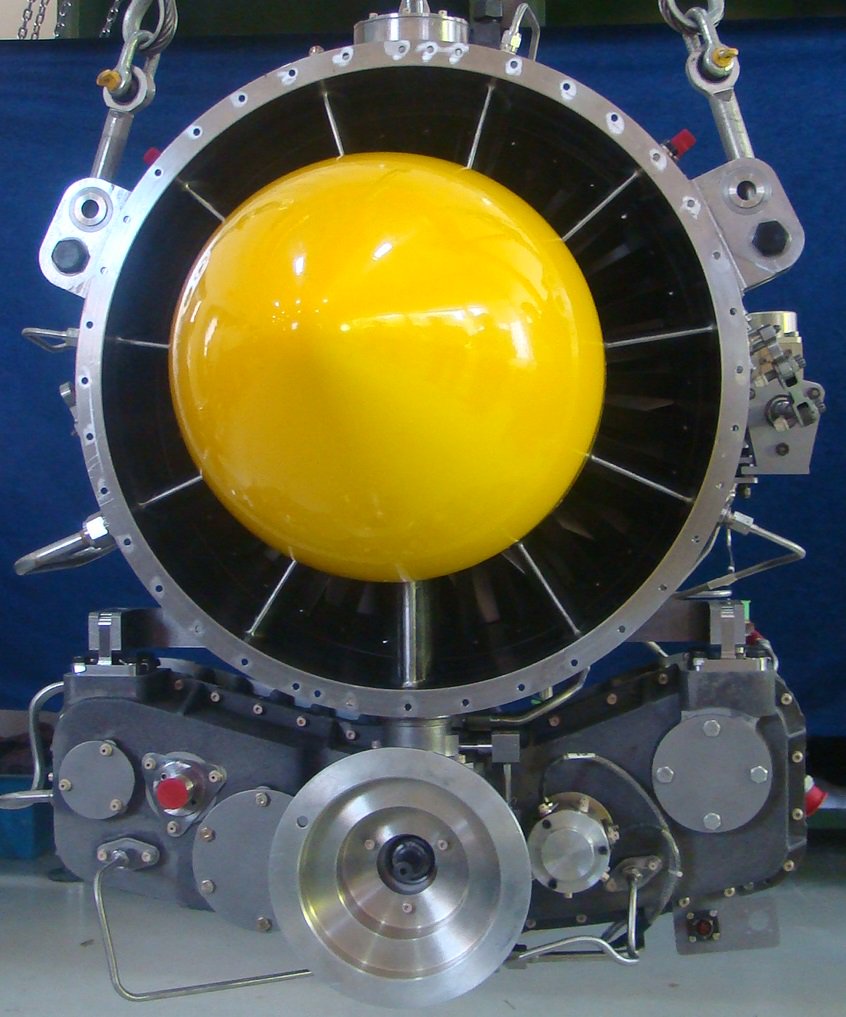
Anantha Krishnan M✈ @writetake
Rear view of 25 kN aero engine from HAL http://bit.ly/1mjz91v @PIB_India @manoharparrikar @Oneindia

Anantha Krishnan M✈ @writetake
And the last one for the day 25 kN aero engine http://bit.ly/1mjz91v @manoharparrikar @Oneindia
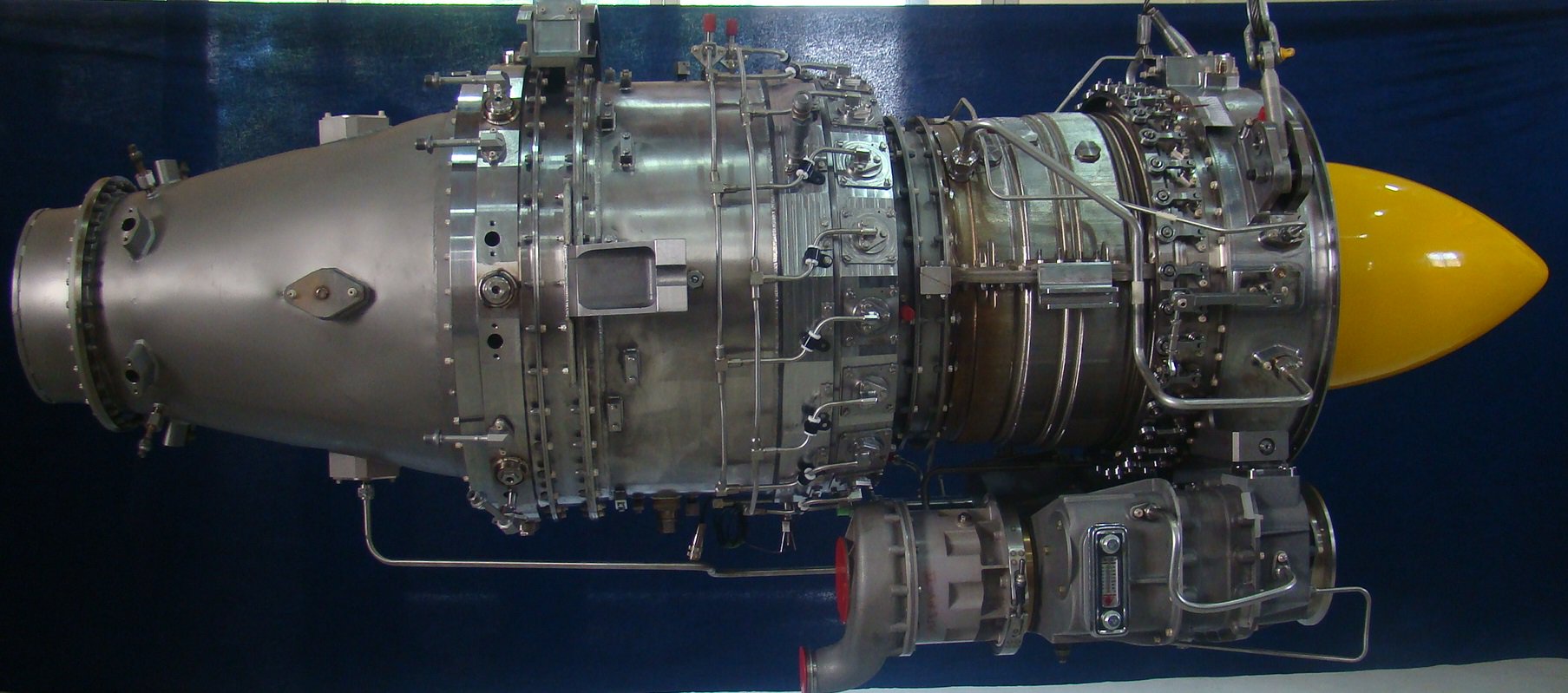
Anantha Krishnan M✈ @writetake
Another view of 25 kN aero engine from HAL http://bit.ly/1mjz91v @PIB_India @manoharparrikar @Oneindia
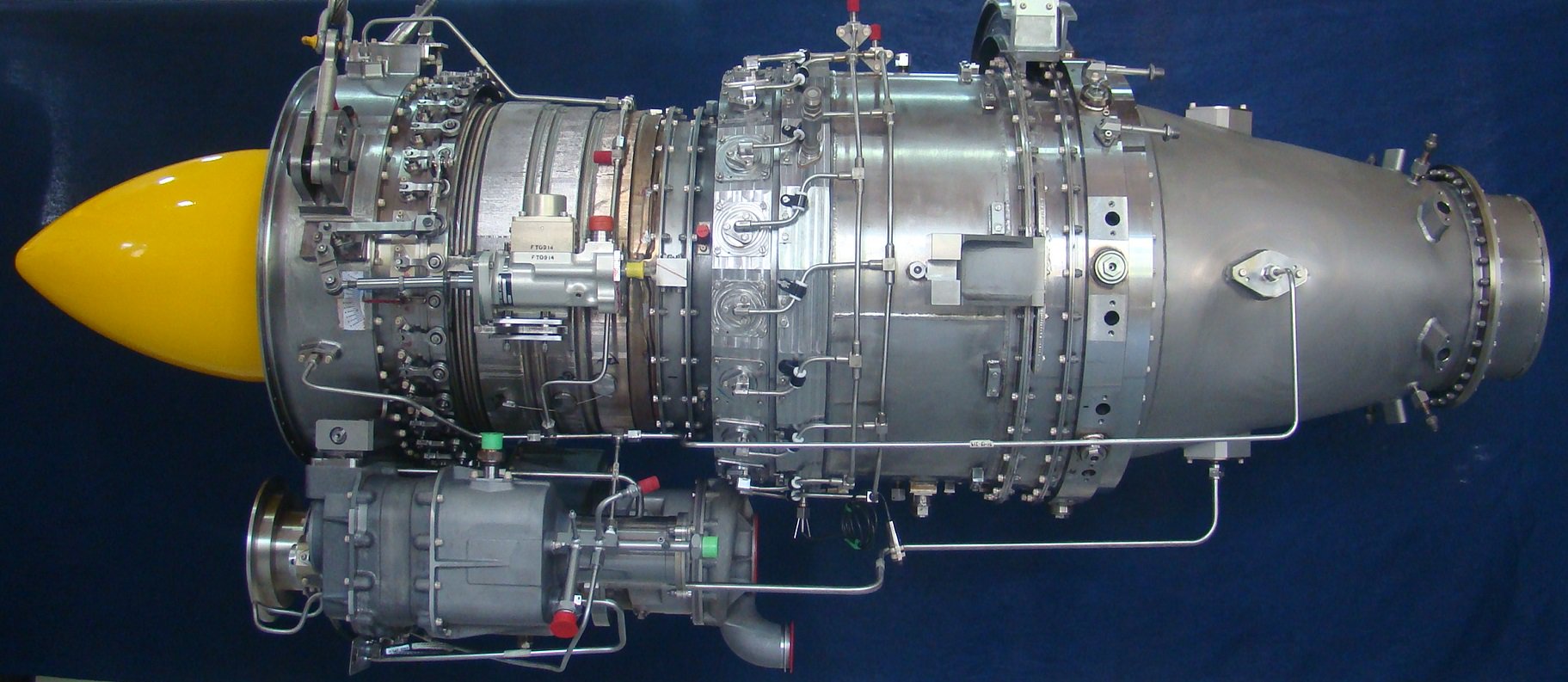
Re: Kaveri & aero-engine discussion
http://www.oneindia.com/india/parrikar- ... 55374.html
Bengaluru, Dec 14: Defence Minister Manohar Parrikar on Monday witnessed a significant event that boosted the Make in India mandate of his government in Bengaluru. Parrikar was at Hindustan Aeronautics Ltd's (HAL) Engine Division on Old Madras Road for the inaugural run of the core 25 kN indigenous aero engine.
Hailed as a landmark event for the aerospace industry and the Make in India movement, the Hindustan Turbo Fan Engine (HTFE-25) maiden run promises a bright era for India's home-grown aeronautical projects. HAL says the engine can be used for basic, intermediate and advanced trainer aircraft. "The engine can also be used on business jets and five tone class aircraft in single engine configuration and on aircraft of up to nine tonne class in the twin engine configuration," says an HAL official.
HAL aims to produce indigenously designed and developed aero engines within a time frame of six years beginning 2013. "In the first phase of the programme, the design of the full engine and manufacture and testing of the technology demonstrator of the core engine are covered. In the subsequent phases the manufacture and testing of the full engine will follow," says the official.
HAL's Bengaluru-based Aero Engine Research & Design Centre (AERDC), HAL, had taken up the design and development of the 25 kN thrust class turbofan engine for basic military trainer aircraft. In future, HAL hopes to design and development Hindustan Turbo Shaft Engine (HTSE-1200) for helicopters of 3.5 tonne class in the single engine configuration (for LUH) and for 5 to 8 ton class in twin engine configuration (for ALH and LCH). 6000 engines needed in the next 20 years Speaking on the occasion, Parrikar asked HAL to stay competitive and play key role in supplying 4000 to 6000 helicopter engines in the next 15-20 years.
"There is a lot of potential in future, with the Make in India programme and other initiatives. So it becomes important that HAL uses its experience and in collaboration with private firms, makes the best use of it. You must not think private guys are only for competition, instead you must take them along and cooperate with them," Parrikar said. He said despite some good work in aeronautics and aerospace sectors, India has failed to pass the threshold barrier to become best in the world.
"We'll have to take quick decisions, expedite processes and as the landscape changes, I must tell you that Bengaluru will play a huge role," he said. He complimented HAL for keeping the HTT-40 Basic Trainer Aircraft project as per the schedule.
Re: Kaveri & aero-engine discussion
^^^
How much collaboration is going on between GTRE and HAL on engines?
How much collaboration is going on between GTRE and HAL on engines?
Re: Kaveri & aero-engine discussion
Wow the HTFE has come up at double speed! 3 years for a working prototype. Happy that we can become independent of the Saturn for IJT, and Adour for the AJT. High time to get the HTSE-1200 done as well.
They had detailed drawings of the parts for the compressor and the HPC blades in some tenders in the first part of this year! I did not see this happening so fast! Probably, it is worth saving the drawings from the tender for posterity.
When modified to a high-bypass engine, it will be nice to see these power business jets, regional jets and possibly a A-10 equivalent .
.
Thanks for those. Really useful. Is there a place I can access this? If not, do you remember the current fan and HPC loadings?nileshjr wrote:These are some notes I had taken from the AI-2015 seminar on the HAL 25kN engine.
They had detailed drawings of the parts for the compressor and the HPC blades in some tenders in the first part of this year! I did not see this happening so fast! Probably, it is worth saving the drawings from the tender for posterity.
When modified to a high-bypass engine, it will be nice to see these power business jets, regional jets and possibly a A-10 equivalent
Re: Kaveri & aero-engine discussion
Srai, Can this replace the Adour engine for the jags?
https://en.wikipedia.org/wiki/Rolls-Roy ... meca_Adour
That would be a very useful thing.
https://en.wikipedia.org/wiki/Rolls-Roy ... meca_Adour
That would be a very useful thing.
Re: Kaveri & aero-engine discussion
Yes sir, it can. Nilesh answered that. However, new parts have to developed like the fan/LP sections, and an afterburner.
Personally, I am against waiting for this engine for the Jaguar. During this time of direly low squadron numbers, and uncertainties, the Jaguars are a well -oiled machine with most parts being made in India. That should not be changed and made hostage to a new development. They should be fitted with the Honeywell engines, Darin upgrades and possibly an El-2032 radar ASAP. That, will make it a damn good strike fighter with enough A2A capability to defend itself in an hour of need. ANY airforce in the world would love to have such a strike fighter.
Personally, I am against waiting for this engine for the Jaguar. During this time of direly low squadron numbers, and uncertainties, the Jaguars are a well -oiled machine with most parts being made in India. That should not be changed and made hostage to a new development. They should be fitted with the Honeywell engines, Darin upgrades and possibly an El-2032 radar ASAP. That, will make it a damn good strike fighter with enough A2A capability to defend itself in an hour of need. ANY airforce in the world would love to have such a strike fighter.
Re: Kaveri & aero-engine discussion
how many Jags are involved in upgrade.? Maybe a couple of later squadrons can be re-engined with these.
Al-55 is for the trainer or SU-30MKI?
Al-55 is for the trainer or SU-30MKI?
Re: Kaveri & aero-engine discussion
All of the Jaguars should be upgraded. At least the quote asked from Honeywell was for 270 engines. We don't need to subvert this order for the HTFE-2500. Even if we get all the trainers, that will be close to 1000 engines over the lifetime. If the core is to be used for turboshafts, the order will get many fold. HAL suggests 4000-6000 engines.
Al-55 are for the trainers. Su-30 engines (123kN) are many times more powerful than the Al-55s(~17kN).
Al-55 are for the trainers. Su-30 engines (123kN) are many times more powerful than the Al-55s(~17kN).
Re: Kaveri & aero-engine discussion
OK. You have made the business case for why Jags should be excluded. 270 engines already ordered.
-
member_29267
- BRFite -Trainee
- Posts: 61
- Joined: 11 Aug 2016 06:14
Re: Kaveri & aero-engine discussion
So, will this go on the IJT? There has already been one change of engine for IJT IIRC...indranilroy wrote:All of the Jaguars should be upgraded. At least the quote asked from Honeywell was for 270 engines. We don't need to subvert this order for the HTFE-2500. Even if we get all the trainers, that will be close to 1000 engines over the lifetime. If the core is to be used for turboshafts, the order will get many fold. HAL suggests 4000-6000 engines.
Al-55 are for the trainers. Su-30 engines (123kN) are many times more powerful than the Al-55s(~17kN).
PS: Does the IAF have need for LIFT aircraft? A supersonic advanced trainer + light attack could be based lined on two of these engines. But I remember having read that IAF is moving towards 2 classes (basic, intermediate) of trainers instead of 3 (including Advanced). If such a trainer is indeed needed, this could be made into a project with significant private contribution.
Last edited by member_29267 on 15 Dec 2015 03:50, edited 1 time in total.
Re: Kaveri & aero-engine discussion
Okay, this report by Ajai Shukla had more tidbits
Cutting-edge Israeli radar wins air force approval for Tejas fighter
Elta is ready to offer ELM-2052 with no development cost/time overhead if it is accepted by at least two aircrafts. HAL says its Mk1A, Jaguars and possibly the Mirages could use these radars. If IAF/HAL's plans work out and MoD doesn't dilly-dally:
1. All 123 Jaguras will be re-engined. 61 will be upgraded with the Darin-3 upgrades and the EL/M-2052 radars. Jaguars with the AESA radar, state of the art short-range and medium-range A2A missiles and 56 kN of dry thrust and 88kN of wet thrust, can easily defend itself.
2. 100 LCA Mk-1As will be having the EL/M-2052 radars
3. The recently upgraded Mirages will be upgraded with the EL/M-2052 radars.
That is about 200 radars.
Cutting-edge Israeli radar wins air force approval for Tejas fighter
Elta is ready to offer ELM-2052 with no development cost/time overhead if it is accepted by at least two aircrafts. HAL says its Mk1A, Jaguars and possibly the Mirages could use these radars. If IAF/HAL's plans work out and MoD doesn't dilly-dally:
1. All 123 Jaguras will be re-engined. 61 will be upgraded with the Darin-3 upgrades and the EL/M-2052 radars. Jaguars with the AESA radar, state of the art short-range and medium-range A2A missiles and 56 kN of dry thrust and 88kN of wet thrust, can easily defend itself.
2. 100 LCA Mk-1As will be having the EL/M-2052 radars
3. The recently upgraded Mirages will be upgraded with the EL/M-2052 radars.
That is about 200 radars.
Re: Kaveri & aero-engine discussion
Awesome !
Is there a plan to proceed till a 40kN class core ?
An aircraft for close in air support could be developed around such an engine - similar to the warthogs or frogfoots.
Both massa & russia have put these ground hugging craft to good use in all recent conflicts involving "non state actors" as combatants - cost savings too when a heavy gun with depleted U is used to swat terrorists & light Armour than say costly hellphyre class missiles by UAVs.
Apart from ADA/HAL for designing and integrating the aircraft , DRDO would be required to design a suitable gun.These guns can be mounted as CIWS for small ships too in the future & targeting systems developed could be further utilized as automated sentry guns to skewer pigs along the Indo-Pak borders
Is there a plan to proceed till a 40kN class core ?
An aircraft for close in air support could be developed around such an engine - similar to the warthogs or frogfoots.
Both massa & russia have put these ground hugging craft to good use in all recent conflicts involving "non state actors" as combatants - cost savings too when a heavy gun with depleted U is used to swat terrorists & light Armour than say costly hellphyre class missiles by UAVs.
Apart from ADA/HAL for designing and integrating the aircraft , DRDO would be required to design a suitable gun.These guns can be mounted as CIWS for small ships too in the future & targeting systems developed could be further utilized as automated sentry guns to skewer pigs along the Indo-Pak borders
Re: Kaveri & aero-engine discussion
Yes, they went from the Larzac engines to the Al-55 engines when there was a weight increase of the IJT. However, the Al-55I engines have not turned up as well as HAl/India would have liked. Plus Russia/Saturn continues to be lackadaisical about its development. They have used the same technique used for the Vikramaditya. After, we made ourselves hostage to their whims, they have asked for huge amounts to continue the development. They keep giving engines with ridiculously low life. This engine will allow us to salvage ourselves from that situation.krishGAgain wrote:So, will this go on the IJT? There has already been one change of engine for IJT IIRC...indranilroy wrote:All of the Jaguars should be upgraded. At least the quote asked from Honeywell was for 270 engines. We don't need to subvert this order for the HTFE-2500. Even if we get all the trainers, that will be close to 1000 engines over the lifetime. If the core is to be used for turboshafts, the order will get many fold. HAL suggests 4000-6000 engines.
Al-55 are for the trainers. Su-30 engines (123kN) are many times more powerful than the Al-55s(~17kN).
A modern turbofan engine is made of three to 4 major parts:
1. A fan which pushes air into a core, and around a core.
2. A core where the air is compressed and fuel is burned. This in turn has a low-pressure (LP) region and a high pressure (HP) region.
3. (optional) An afterburner section between the core and nozzle, where extra fuel can be burnt for higher thrust.
4. A nozzle for the exhaust
Among the above 4, number 2 is often the technologically most challenging. This is the part that HAL is perfecting first. Once that is done, they can change 1,3 and 4 modularly around the core to increase/decrease the thrust and fuel efficiency etc. So, this engine can be adapted from 20kN to 45kN based on the choices of 1,3 and 4. It can be used for IJT with a different configuration, for an AJT with yet another configuration, Jaguars with AJT configuration + afterburners, a small regional jet/HALE UAV in a more fuel-efficient configuration with a larger fan.
If the core works well it can be used for turboshafts for helicopters, and turboprops for basic-trainers, regional airliners and transport aircrafts etc.
Re: Kaveri & aero-engine discussion
The engines of the Warthog and the frogfoots are very different. The engine on the Warthog is a high bypass-engine producing 41kN. Its core however makes much less and is in fact of similar size to the core of HTFE-25.Lilo wrote:Awesome !
Is there a plan to proceed till a 40kN class core ?
An aircraft for close in air support could be developed around such an engine - similar to the warthogs or frogfoots.
Re: Kaveri & aero-engine discussion
Maitya, Nilesh, you might find some nuggets of info in GTRE's tender for Forgings for high pressure distortion tolerance fan development
Re: Kaveri & aero-engine discussion
Sorry to digress. You post struck me and I spent some time with kookal. As you rightly pointed out the A-10 has a high bypass turbofan (6:1). I wondered about that because high bypass turbofans (apart from having a low IR signature - useful for A-10) suffer from the drawback that they are best at high altitude and they take more time to spool up so sudden acceleration as required by a fighter is less likely for the A-10. Also the efficiency/range advantages of high bypass are lost at the low altitudes that the A-10 is used.indranilroy wrote: The engines of the Warthog and the frogfoots are very different. The engine on the Warthog is a high bypass-engine producing 41kN. Its core however makes much less and is in fact of similar size to the core of HTFE-25.
Looks like they wanted a low IR signature and did not want spectacular fighter like acceleration. It's radius too is about 450 km - OK but not "really long legs".
Re: Kaveri & aero-engine discussion
Is this thing good to go for Nirbhay or needs downsizing? Cost is key there as it needs to work only twice...once for factory test and once for 90 mins but must be durable in storage for ten years...fuel efficiency and low exhaust signature is a must.
Re: Kaveri & aero-engine discussion
To answer it myself it's not a cm micro turbofan.
THE THAWK engine is 66kg weight, 3 kn thrust and 0.68 sfc
THE THAWK engine is 66kg weight, 3 kn thrust and 0.68 sfc
-
Neela
- BRF Oldie
- Posts: 4104
- Joined: 30 Jul 2004 15:05
- Location: Spectator in the dossier diplomacy tennis match
Re: Kaveri & aero-engine discussion
Manik engine is for LRCMs. 450 kgf or around 4.5kn of thrust.....last heard end of 2014 where it was ubdergoing endurance tests
Re: Kaveri & aero-engine discussion
HAL should work with private sector: Parrikar
Manohar Parrikar, Minister of Defence and T Suvarna Raju Chairman and Managing director Hindustan Aeronautics Limited ( HAL ) during the maiden run of India's own indigenous 25 kN Aero Engine being produced by HAL in Bengaluru on Monday 14 December 2015. Photo : Sudhakara Jain.
Defence Minister Manohar Parrikar said on Monday that India would need 4,000 to 6,000 helicopter engines in the next 15 to 20 years.
“If you make it in the time frame allotted, it will be a big achievement,” he said. Mr. Parrikar was speaking after launching the maiden run of the core of 25 kN indigenous Aero Engine (Hindustan Turbo Fan Engine – HTFE 25) developed by the Hindustan Aeronautics Ltd.
To be used in military trainer aircraft, small regional jets and unmanned applications, the engine’s launch coincided with HAL’s 75 year of existence.
The design of the Hindustan Turbo Shaft Engine (HTSE-1200) was also launched during the occasion.
Though the Defence Minister commended India’s progress in aeronautical engineering, he said, “But we haven’t been able to pass that threshold required to go into the higher sector of aeronautical engineering.”
He stressed on the need for companies like HAL to work with the private sector on a “competition-cooperation” basis, as well as for completion of projects on time, as the HAL had “almost” done. This would facilitate exports, with the Indian Air Force already having placed an initial order of 72 trainers.
With exports from the country having grown six times, Mr. Parrikar said defence equipment could be a big item of export if procedures were cleared faster, especially to countries which could not afford top-notch equipment available.
Defence trade
As for the Defence Trade and Technology Initiative (DTTI), the Minister said the programme was in the final stages. Mr. Parrikar recently visited the U.S. “India, in the next five to 10 years, can be a global hub for aeronautical development,” he said, adding that Bengaluru would be an important part of it.
Manohar Parrikar, Minister of Defence and T Suvarna Raju Chairman and Managing director Hindustan Aeronautics Limited ( HAL ) during the maiden run of India's own indigenous 25 kN Aero Engine being produced by HAL in Bengaluru on Monday 14 December 2015. Photo : Sudhakara Jain.
Defence Minister Manohar Parrikar said on Monday that India would need 4,000 to 6,000 helicopter engines in the next 15 to 20 years.
“If you make it in the time frame allotted, it will be a big achievement,” he said. Mr. Parrikar was speaking after launching the maiden run of the core of 25 kN indigenous Aero Engine (Hindustan Turbo Fan Engine – HTFE 25) developed by the Hindustan Aeronautics Ltd.
To be used in military trainer aircraft, small regional jets and unmanned applications, the engine’s launch coincided with HAL’s 75 year of existence.
The design of the Hindustan Turbo Shaft Engine (HTSE-1200) was also launched during the occasion.
Though the Defence Minister commended India’s progress in aeronautical engineering, he said, “But we haven’t been able to pass that threshold required to go into the higher sector of aeronautical engineering.”
He stressed on the need for companies like HAL to work with the private sector on a “competition-cooperation” basis, as well as for completion of projects on time, as the HAL had “almost” done. This would facilitate exports, with the Indian Air Force already having placed an initial order of 72 trainers.
With exports from the country having grown six times, Mr. Parrikar said defence equipment could be a big item of export if procedures were cleared faster, especially to countries which could not afford top-notch equipment available.
Defence trade
As for the Defence Trade and Technology Initiative (DTTI), the Minister said the programme was in the final stages. Mr. Parrikar recently visited the U.S. “India, in the next five to 10 years, can be a global hub for aeronautical development,” he said, adding that Bengaluru would be an important part of it.
-
vina
- BRF Oldie
- Posts: 6046
- Joined: 11 May 2005 06:56
- Location: Doing Nijikaran, Udharikaran and Baazarikaran to Commies and Assorted Leftists
Re: Kaveri & aero-engine discussion
TOI(let) says that in addition to the 25KN turbofan engine, HAL is developing a HTSE 1200 (i.e. 1200 bhp turbo shaft engine ) for helicopters , basically for the LUH (1 engine) and Dhruv (twin engine).
Now if they put in gear train and stuff in front of a customised LP spool , you can get a Turbo Prop as well, which might be decent for Dornier or slightly larger sized planes.
Now if they put in gear train and stuff in front of a customised LP spool , you can get a Turbo Prop as well, which might be decent for Dornier or slightly larger sized planes.
Re: Kaveri & aero-engine discussion
AI 2015 seminar site still around. This session was most interesting of all. There is one more seminar in the same video regarding Al-31FP and how it could be possible to extend the life beyond 2000hrs. Certification wil be done by HAL perhaps. That's a very good initiative. Interestingly till now not a single Al-31FP from IAF has surpassed its full life as per the seminar. They are waiting for that to happen for more testing.indranilroy wrote: Thanks for those. Really useful. Is there a place I can access this? If not, do you remember the current fan and HPC loadings?
http://aeroindialive.nic.in/show_ondema ... id_part=31
This same core can be used up to 40kN easily. Not a real 40kN class engine but still near enough. Scaling the core by say 1.25 or 1.5 factor could be a easier task than re-designing entire new engine. But please note that due to smaller size HAL could leverage 3D printing for this engine. This advantage could be lost for bigger engine. With same core but using GTF config for going to Ultra high BP a bigger engine is definitely possible. They can give feasibility study task to some IIT and it it seems worth doing should fund a tech demo engine with GTF technology. This technology could be used in future for bigger engines for airliners. A lot of possibilities exist. There should be someone at helm who has vision and willing to put money on RnD.Lilo wrote:Awesome !
Is there a plan to proceed till a 40kN class core ?
IR has already answered it. Just to add some tidbit. this engine is designed keeping in mind IJT for now. But phase one is all about certifying only the core. Entire engine to be certified in Phase 2. This will let them have a proven core readily available for other aircraft specific engine project without unnecessary delay. I am impressed at the project management for this particular project. HAL team was bold and aggressive and pragmatic.krishGAgain wrote:So, will this go on the IJT? There has already been one change of engine for IJT IIRC...
Also as we know the Al-55 engine had ridiculously low - 150hrs of MTBO
Last edited by JayS on 15 Dec 2015 09:58, edited 1 time in total.
Re: Kaveri & aero-engine discussion
Yes vina ji. Found another article in gazettestandard. I hope this is just a tipping point in local engine manufacture, and wish to see a family more capable engines roll by.vina wrote:TOI(let) says that in addition to the 25KN turbofan engine, HAL is developing a HTSE 1200 (i.e. 1200 bhp turbo shaft engine ) for helicopters , basically for the LUH (1 engine) and Dhruv (twin engine).
Now if they put in gear train and stuff in front of a customised LP spool , you can get a Turbo Prop as well, which might be decent for Dornier or slightly larger sized planes.
Last edited by Kailash on 15 Dec 2015 10:19, edited 1 time in total.
-
Neela
- BRF Oldie
- Posts: 4104
- Joined: 30 Jul 2004 15:05
- Location: Spectator in the dossier diplomacy tennis match
Re: Kaveri & aero-engine discussion
With 2 of these modified as high bypass variants regional jets and transport aircraft for military are possible too.
Re: Kaveri & aero-engine discussion
Thanks for the explanations Indranil & Nilesh garus,
Some pics of interest(especially wrt 3D printed turbine blades) from the HTFE-25 presentation culled from https://aquantumofmind.wordpress.com/2015/10/
- apologies if posted before.
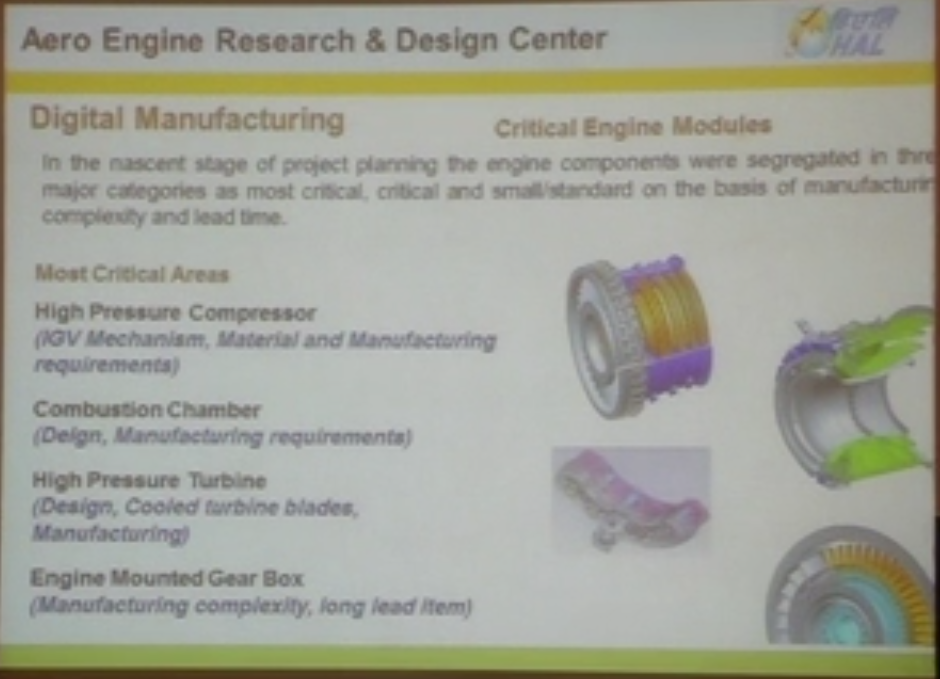


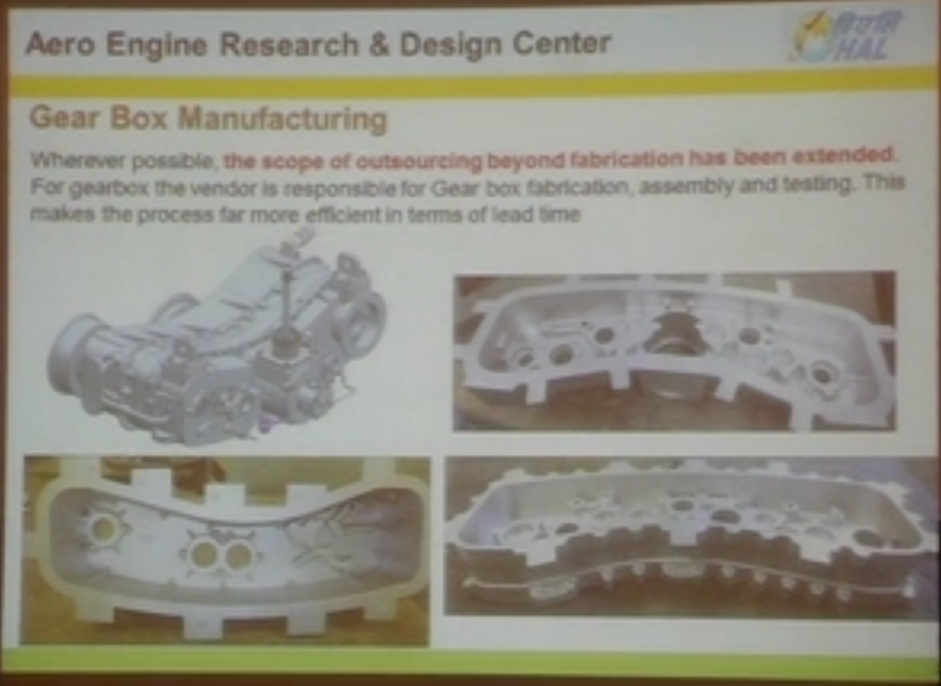
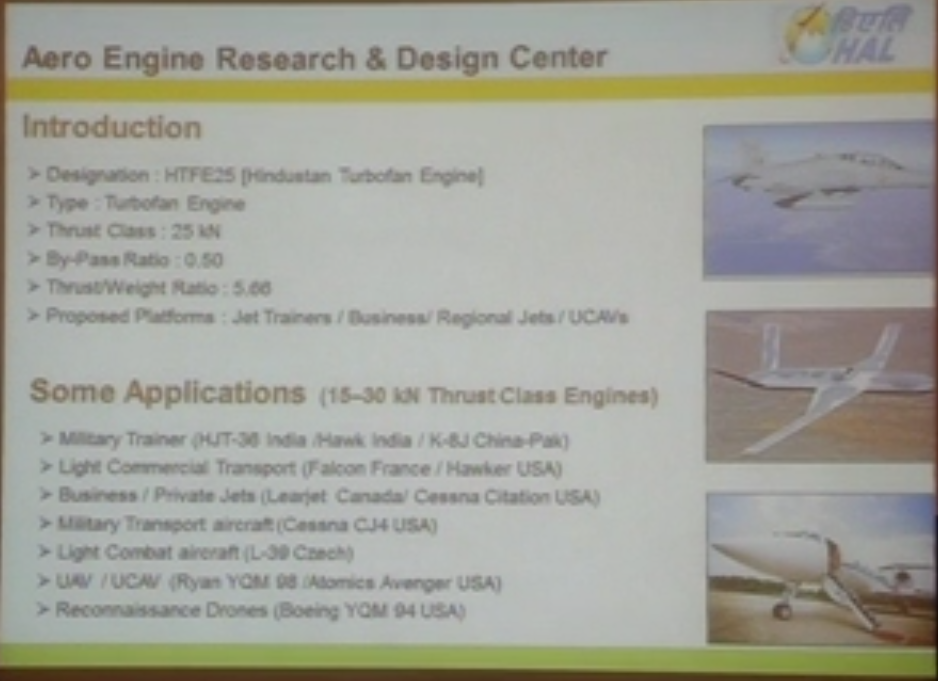

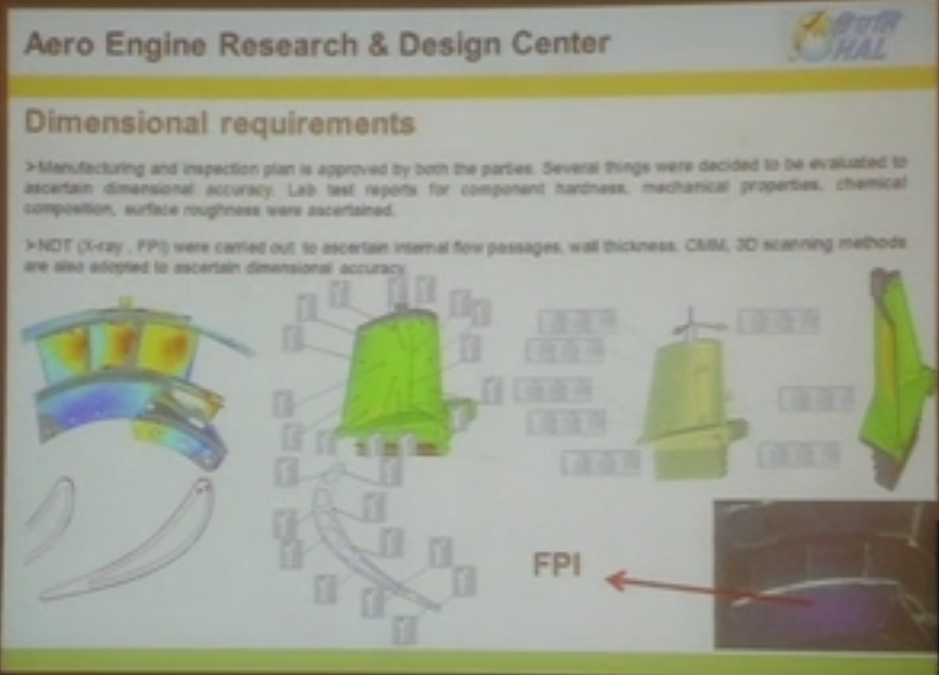
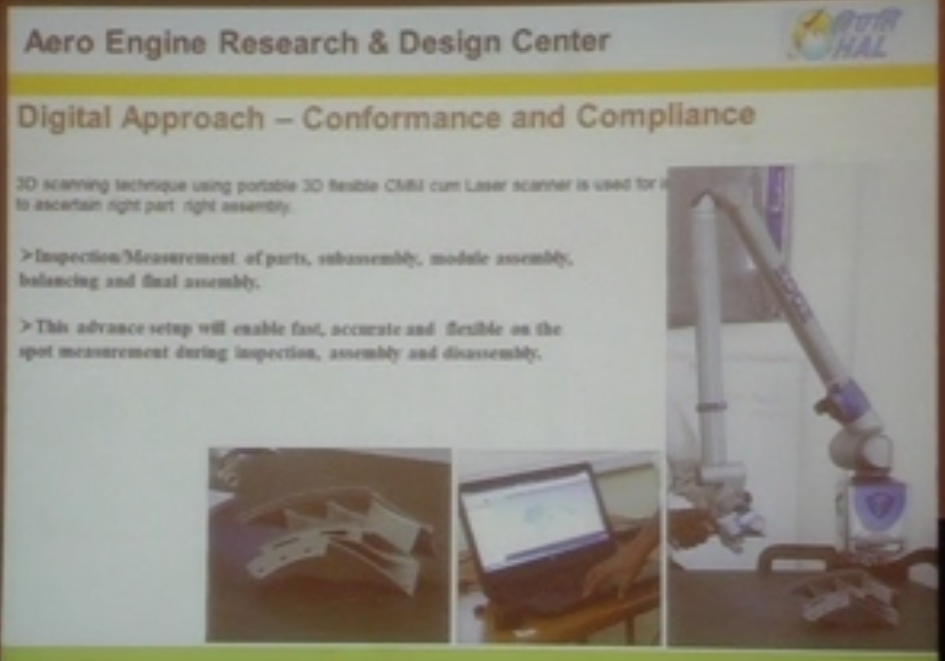
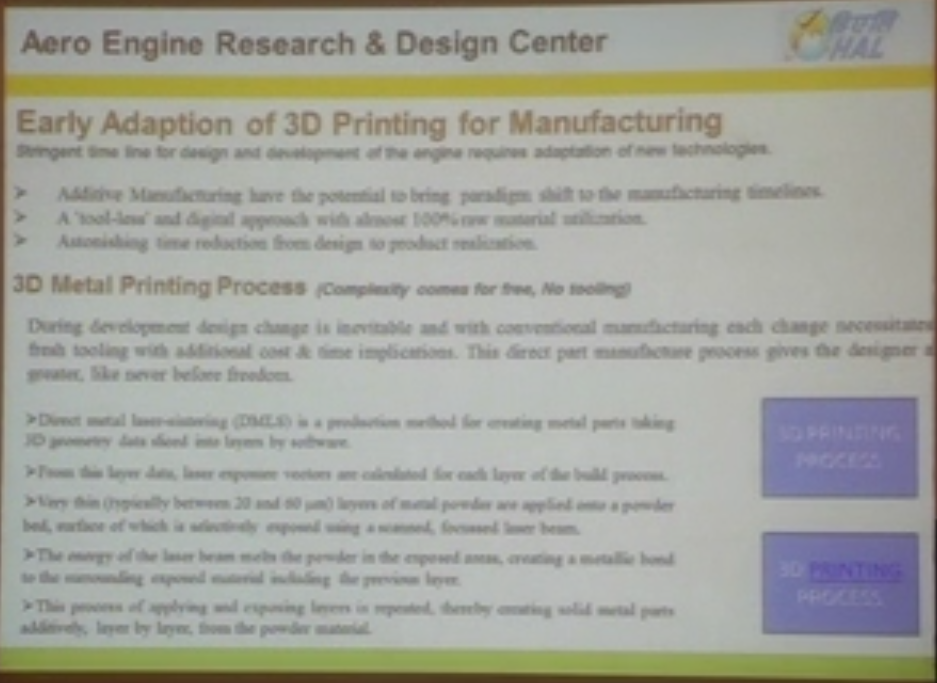
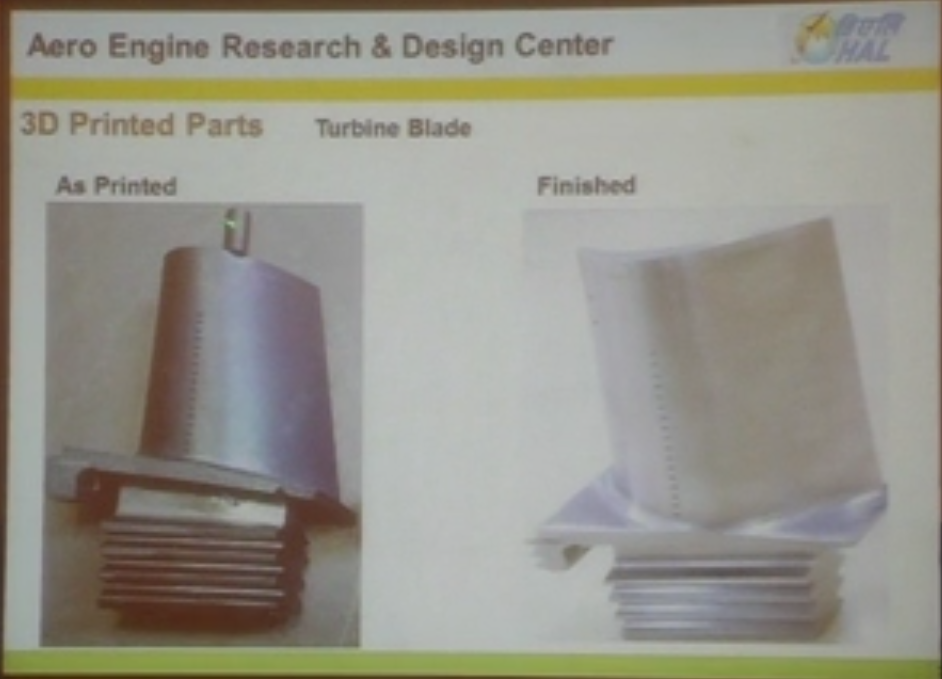
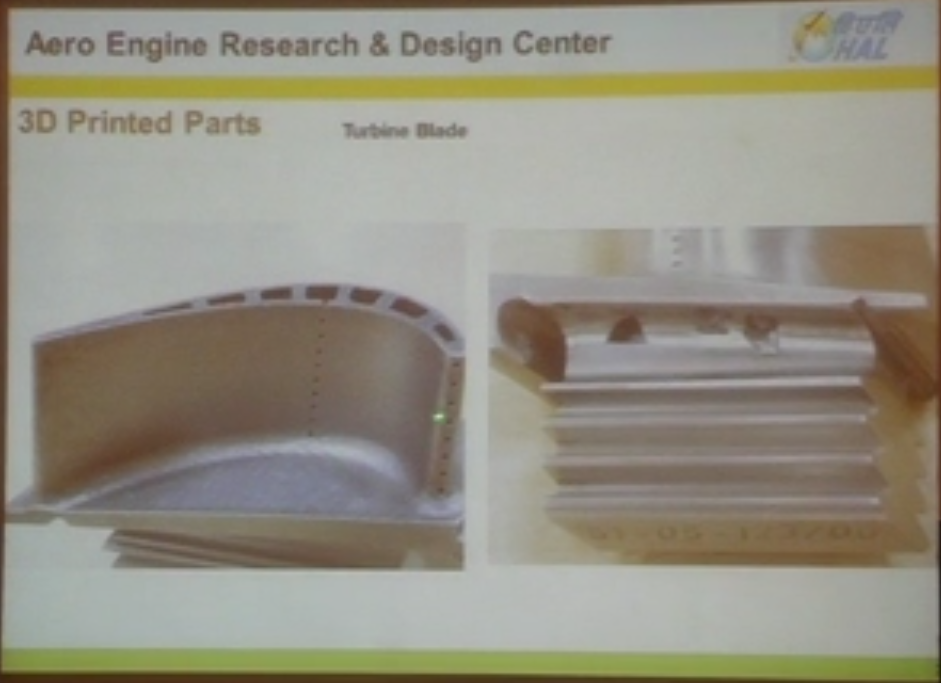
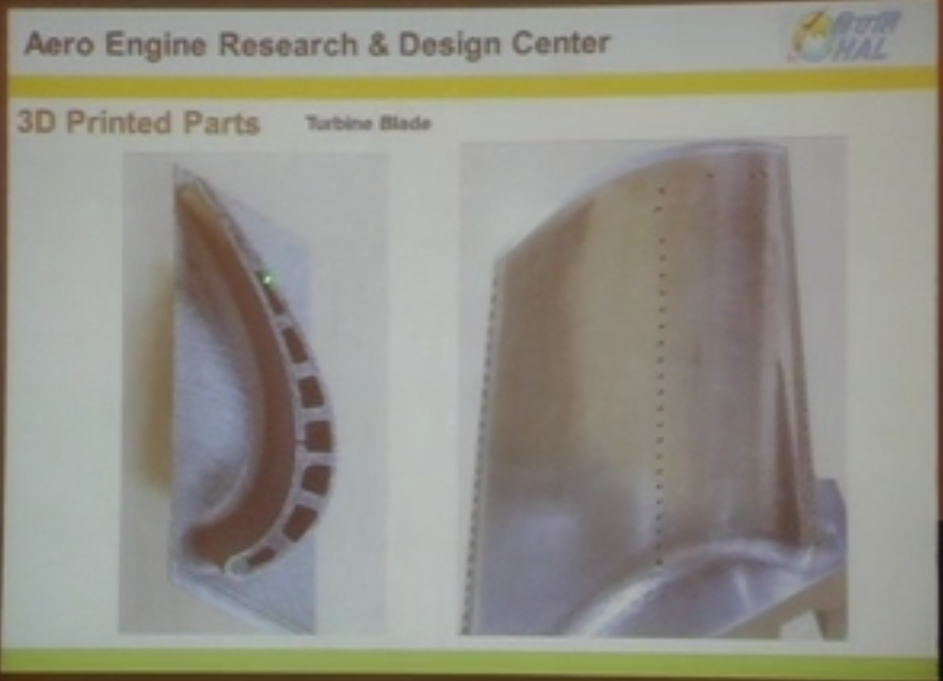
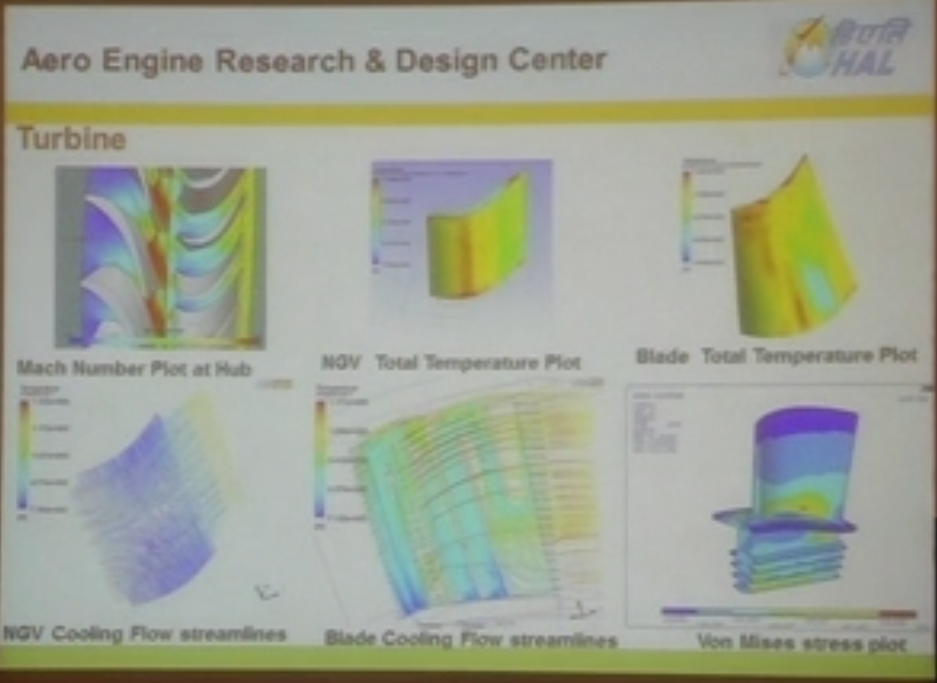
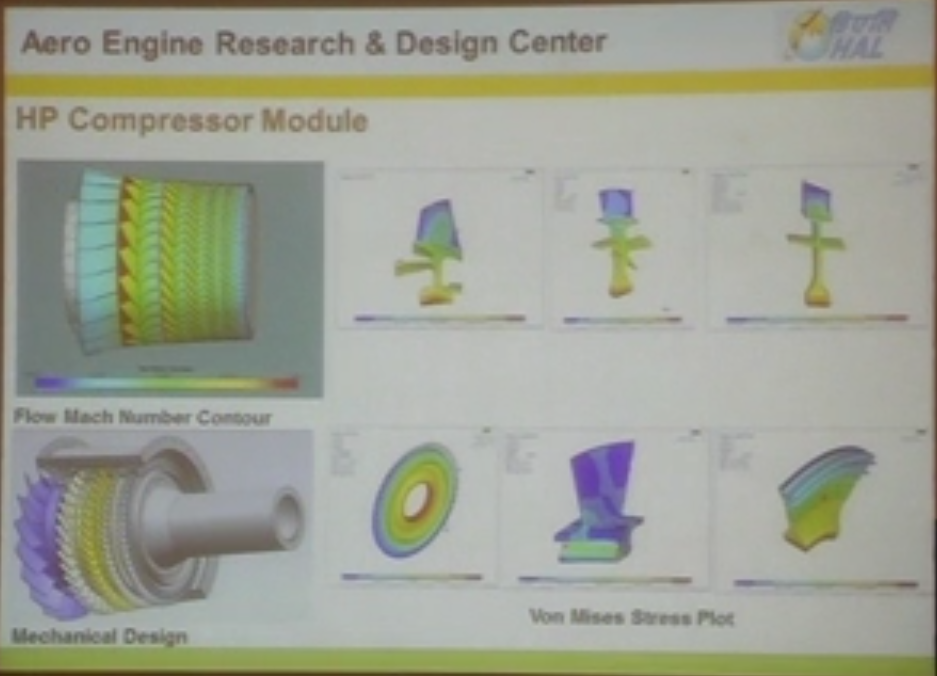

Some pics of interest(especially wrt 3D printed turbine blades) from the HTFE-25 presentation culled from https://aquantumofmind.wordpress.com/2015/10/
- apologies if posted before.















Re: Kaveri & aero-engine discussion
^^ That's my webpage.  Screenshots from the AI seminar video only. The seminar is a must watch. Link posted above.
Screenshots from the AI seminar video only. The seminar is a must watch. Link posted above.